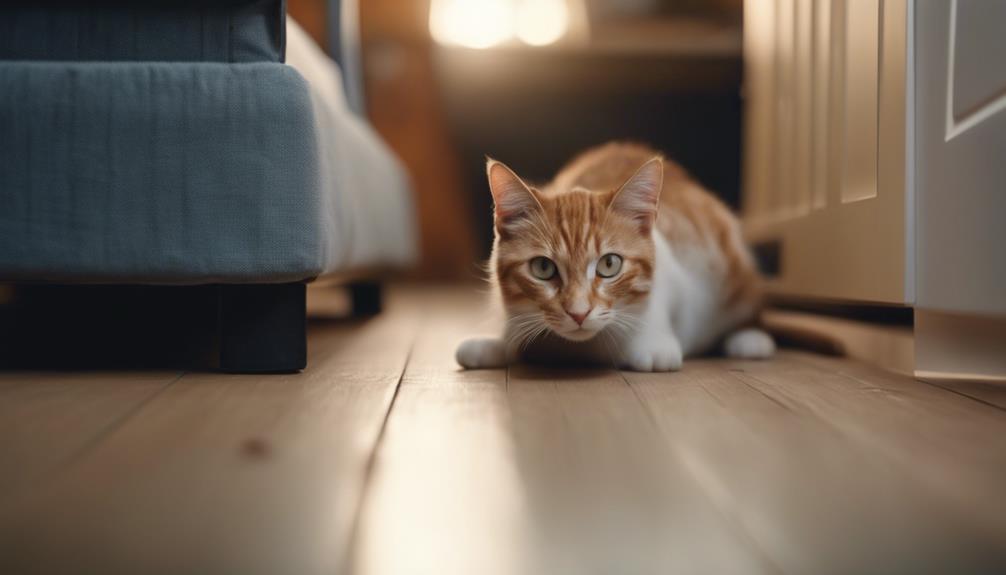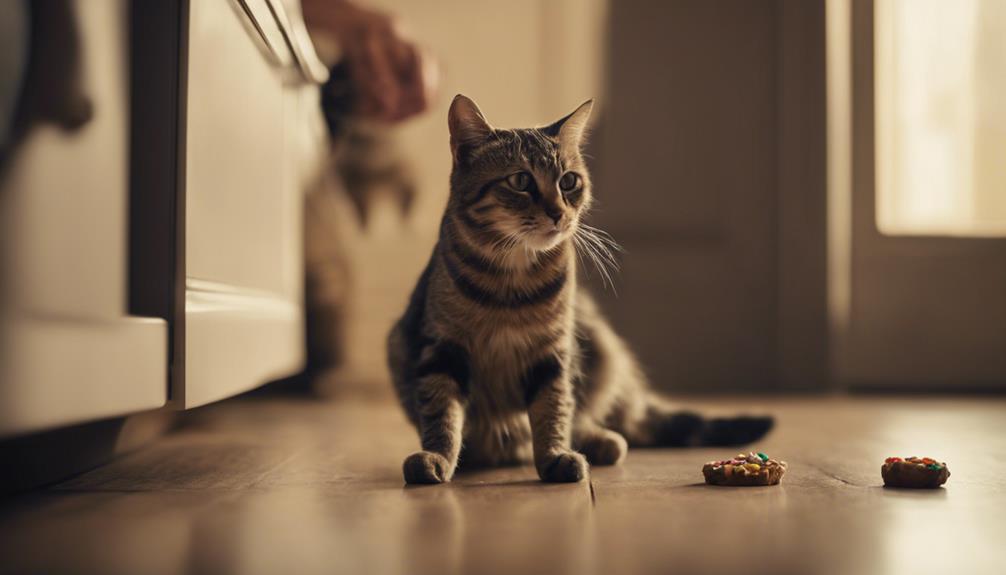How to Build Trust With a Cat Before Socialization

Building trust with your cat before socialization is crucial for a strong bond. This process is based on mutual respect and patience.
Here are some key steps to follow:
- Create a Safe Environment: Make sure your cat has a safe and comfortable space to retreat to when feeling overwhelmed.
- Respect Their Boundaries: Allow your cat to approach you on their terms and avoid forcing interactions.
- Use Positive Reinforcement: Reward good behavior with treats or praise to encourage positive associations.
- Establish a Routine: Cats thrive on routine, so establish consistent feeding and play times to build trust.
- Be Patient and Understanding: Building trust takes time, so be patient and understanding of your cat's needs.
- Communicate Through Body Language: Pay attention to your cat's body language and respond accordingly to build trust.
By following these key steps, you can build a strong bond with your cat based on mutual respect and patience.
Understanding a Cat's Behavior
Understanding a cat's behavior can be a fascinating journey into the intricate world of feline communication and instincts. Cats communicate through various subtle cues, such as body language, vocalizations, and scent marking. Bonding cues like slow blinking, head-butting, and purring signify trust and affection. To build trust with a cat, it's essential to observe and respond to these communication signals accordingly.
Trust building activities play a crucial role in a cat's socialization progress. Spending quality time engaging in interactive play sessions, providing tasty treats, and gentle petting can help strengthen the bond between the cat and their caregiver. Consistency, patience, and respect for the cat's boundaries are key elements in fostering trust and building a positive relationship.
Creating a Safe Environment

To ensure a cat feels secure and comfortable, creating a safe environment is paramount in fostering trust and promoting their well-being. Cats, known for their need for safety and personal space, thrive in environments where they feel secure. Here are some essential steps to create a safe space for your feline friend:
- Creating Boundaries: Establishing boundaries within your home is crucial. Cats appreciate having designated areas for eating, playing, and resting. This helps them feel in control of their environment, contributing to their sense of security.
- Providing Space: Cats are independent creatures that value their personal space. Make sure to offer hiding spots and elevated areas where they can retreat when they need some alone time. Having access to high perches allows them to observe their surroundings and feel safe.
- Safe Hideaways: Set up cozy hiding spots like covered beds or quiet corners where your cat can retreat when feeling anxious or overwhelmed. These hideaways provide a sense of security and comfort.
- Eliminate Stressors: Identify and remove any potential stressors in the environment. Loud noises, sudden movements, or unfamiliar scents can make a cat feel uneasy. By creating a calm and predictable atmosphere, you help your cat feel safe and at ease.
Respectful Approach and Body Language

Approaching a cat with gentleness and respect is key to building a trusting relationship. Using gentle handling techniques and maintaining a non-threatening posture can help create a safe space for the cat to feel comfortable and secure.
Gentle Handling Techniques
When handling a cat gently, it's essential to approach with calmness and awareness of your body language. Cats are sensitive creatures that respond well to respectful handling. Here are some gentle handling techniques to help you build trust and rapport with your feline friend:
- Approach Slowly: Avoid sudden movements that may startle the cat.
- Use Soft Voice: Speak in a soothing tone to create a calming environment.
- Petting Techniques: Start by petting the areas where the cat enjoys being touched.
- Respect Boundaries: Allow the cat to set the pace and avoid forcing interactions.
Non-Threatening Posture
Using a non-threatening posture and maintaining a respectful approach with appropriate body language is crucial for establishing trust and communication with your cat. Understanding feline body language is key; cats communicate through their posture, tail movements, and facial expressions. Trust-building exercises involve approaching your cat slowly, avoiding direct eye contact, and allowing the cat to initiate interaction. To convey respect and build trust, avoid sudden movements, crouching over the cat, or reaching out abruptly. Instead, sit or crouch at the cat's level, offering a relaxed body posture and gentle voice. By showing sensitivity to your cat's signals and responding appropriately, you can create a safe space for them to feel comfortable and secure.
| Non-Threatening Posture Tips | Examples | Benefits |
|---|---|---|
| Approach slowly and calmly | Walking towards the cat at a steady pace | Helps reduce stress and anxiety in the cat |
| Avoid looming over the cat | Sitting or crouching at the cat's level | Establishes a sense of safety and security |
| Respect personal space | Allowing the cat to come to you for interaction | Builds confidence and reinforces positive associations |
Establishing a Routine for Feeding

Establishing a routine for feeding is vital in building trust with a cat. By providing regular meal times and a consistent feeding schedule, a cat can feel secure and develop a sense of predictability.
This routine helps create a bond of trust between the cat and its caregiver, fostering a positive relationship.
Regular Meal Times
Building trust with a cat involves setting regular meal times to establish a routine for feeding. Cats are creatures of habit and thrive on consistency. Here are some key points to consider when implementing regular meal times:
- Predictability: Cats feel secure when they know when to expect their meals. Consistent meal times help create a sense of predictability for your feline friend.
- Bonding Opportunity: Feeding times can be an excellent opportunity to strengthen the bond between you and your cat. It's a time for interaction and positive reinforcement.
- Health Benefits: A regular feeding schedule promotes good health by ensuring your cat receives the necessary nutrients at appropriate times.
- Behavioral Stability: Establishing routine meal times can contribute to your cat's overall behavior and well-being by reducing anxiety and stress related to food.
Consistent Feeding Schedule
A consistent feeding schedule is crucial for a cat's well-being and helps establish a sense of security and routine in their daily life. Trust building exercises are enhanced through feeding consistency. Cats thrive on predictability, making a reliable schedule key to their emotional and physical health.
Mealtime bonding isn't just about nourishment; it's a time for connection and reassurance. By feeding your cat at the same times each day, you create a dependable environment that fosters trust and comfort. Cats quickly learn to anticipate their meals, building a positive association with you as their caregiver.
Consistency in feeding also aids in regulating their digestive system and can prevent behavioral issues that may arise from irregular meal times.
Utilizing Positive Reinforcement Techniques

Positive reinforcement techniques are effective in fostering trust and bond with a cat. When trying to build a connection with a feline friend, using positive reinforcement can be a game-changer. Here are some essential techniques to consider:
- Clicker Training: Utilizing a clicker along with treats can help reinforce positive behaviors in cats. Clicker training provides a clear signal to the cat when they've done something right, making it easier for them to understand what you're rewarding them for.
- Treats: Offering tasty treats as a reward for desired behaviors can motivate cats to engage with you and build trust over time. Choose treats that your cat loves and use them consistently to reinforce positive interactions.
- Calm Demeanor: Cats respond well to a calm and gentle approach. Maintaining a relaxed demeanor and avoiding sudden movements can help the cat feel more at ease and open to forming a bond.
- Patience: Building trust takes time, especially with cats who may be cautious or fearful. Patience is key when using positive reinforcement techniques; give your cat the space and time they need to feel comfortable and secure in your presence.
Allowing the Cat to Initiate Contact

When allowing the cat to initiate contact, observe their body language and cues to gauge their comfort level and readiness for interaction. Patient observation is key; look for signs like relaxed posture, slow blinking, or gentle tail movements that indicate a positive mood. Approach the cat gradually, allowing them to set the pace. Respect their boundaries and avoid forcing contact. This approach fosters mutual respect and helps in building trust with the cat.
Mutual respect is essential when allowing the cat to take the lead in initiating contact. By letting the cat dictate the terms of interaction, a foundation of trust can be established. Cats are sensitive to their environment and interactions, so honoring their cues demonstrates that you're considerate of their needs. This respectful approach sets the stage for a positive relationship based on trust and understanding. Remember, every cat is unique, so be patient and allow the relationship to develop at its own pace.
Building Trust Through Play and Interaction

To build trust with a cat through play and interaction, it's important to engage in activities that cater to their natural instincts and preferences. Cats are curious and playful creatures, and by participating in interactive play, you can create a bond based on positive experiences.
Here are some key strategies for building trust through play and interaction:
- Interactive Play: Engage in activities that stimulate your cat's hunting instincts, such as using wand toys or laser pointers. This type of play allows your cat to express themselves naturally and helps in building a connection with them.
- Gradual Bonding: Take the time to understand your cat's comfort levels and boundaries. Gradually introduce new activities and interactions to prevent overwhelming them, thus fostering trust over time.
- Building Trust: Use treats and verbal praise as positive reinforcement during play sessions. This encourages your cat to associate your presence with enjoyable experiences, strengthening the bond of trust between you both.
- Consistency is Key: Establish a routine for play and interaction to provide your cat with a sense of security and predictability, further solidifying the trust between you. Remember, patience and understanding are fundamental when building trust with your feline friend.
Frequently Asked Questions
How Can I Know if My Cat Is Feeling Stressed or Anxious?
A cat's stress or anxiety can be observed through its body language and behavioral cues. Signs such as flattened ears, dilated pupils, excessive grooming, or hiding can indicate distress. Understanding these indicators helps in providing comfort and support.
What Are Some Common Mistakes That People Make When Trying to Build Trust With a Cat?
When trying to build trust with a cat, common mistakes include misinterpreting body language and rushing patience training. It's essential to observe cues and progress at the cat's pace to establish a strong bond.
Is It Possible to Build Trust With a Cat That Has Had Previous Negative Experiences With Humans?
Building trust with a cat that has had negative experiences with humans is possible. Trust-building exercises and positive reinforcement techniques can help create a safe environment and gradually earn the cat's trust and improve their relationship with humans.
How Can I Help My Cat Feel More Comfortable Around Strangers or Visitors?
To help a cat feel comfortable around strangers or visitors, observe their body language for signs of stress. Offer treats, engage in playtime, and consider using pheromone diffusers. Gradually introduce new people, allowing the cat to approach at their own pace.
Are There Any Specific Foods or Treats That Can Help Strengthen the Bond With My Cat?
For strengthening the bond with a cat, favorite treats and interactive toys can work wonders. Cats often respond positively to tasty treats and engaging playtime, paving the way for a deeper connection and trust to blossom.











